Why the first Webb telescope images mean so much to scientists
Although not part of Webb’s core science mission, the first five images released to the public have a lot to tell scientists
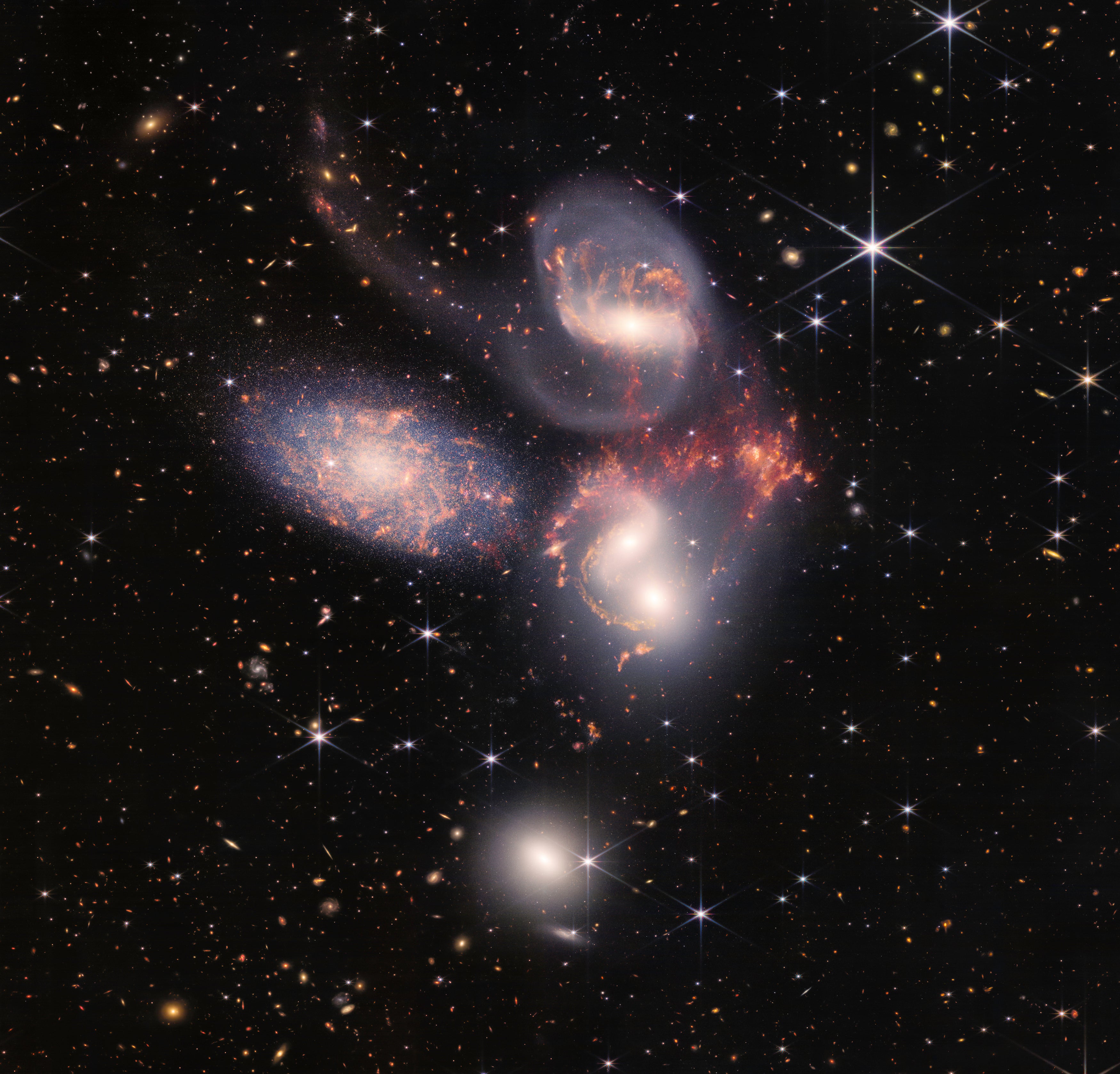
Your support helps us to tell the story
From reproductive rights to climate change to Big Tech, The Independent is on the ground when the story is developing. Whether it's investigating the financials of Elon Musk's pro-Trump PAC or producing our latest documentary, 'The A Word', which shines a light on the American women fighting for reproductive rights, we know how important it is to parse out the facts from the messaging.
At such a critical moment in US history, we need reporters on the ground. Your donation allows us to keep sending journalists to speak to both sides of the story.
The Independent is trusted by Americans across the entire political spectrum. And unlike many other quality news outlets, we choose not to lock Americans out of our reporting and analysis with paywalls. We believe quality journalism should be available to everyone, paid for by those who can afford it.
Your support makes all the difference.The first full-color James Webb Space Telescope images released Tuesday did not disappoint, as the now operational telescope returned images of glowing nebulae, dancing galaxies and the most distant star systems with never-before-seen resolution.
Scientists were as much in awe as the general public.
“My reaction was very much not professional,” Jacob Bean, an astronomer who studies exoplanets at the University of Chicago, said in an interview with The Independent. “Just overwhelmed and blown away by the level of detail, the rich detail that you saw in these images.”
But the images weren’t just about communicating the sublime.
Although the five images released Tuesday were relatively quick exposures designed to show the world what Webb can do, they’ve nevertheless provided scientifically useful information that has whet the appetite of the astronomical community for more rigorous observations. The information contained in a spectrum of light from the atmosphere of exoplanet Wasp-96b already has Dr Bean salivating for what Webb will do for his field of study.
“It’s really just going to blow open this field of exoplanet atmospheres,” he said.
Although US President Joe Biden did preview one of the Webb images Monday night, Nasa presented the full set of Webb’s first five public observations during a live webcast showcase on Tuesday morning. These included the first Webb deep field image, the deepest image of the universe taken so far, images of the bright Carina and Southern Ring nebulae, a collection of distant galaxies trapped in a tight gravitational dance known as Stephan’s Quintet, and the Wasp-96b spectrum.
All of the observations highlight aspects of Webb’s mission, which includes studying the evolution of the earliest galaxies, how stars and planets form, as well as studying other planets and searching for signs of life on them.
The Webb deep field image would not have been possible without a telescope in space as big as Webb, which has a primary mirror 6.5-metres in diameter compared with the 2.4-metre mirror of the Hubble Space Telescope.
To create the image, Webb pointed its massive mirror at a tiny patch of dark space about the size of a sand grain held at an arm’s length and took 12.5 hours of exposures. The resulting image of thousands of glowing gem-like galaxies reveals some that are 13.1 billion light years away, and because a light year is the distance light travels in a year, 13 billion years old.
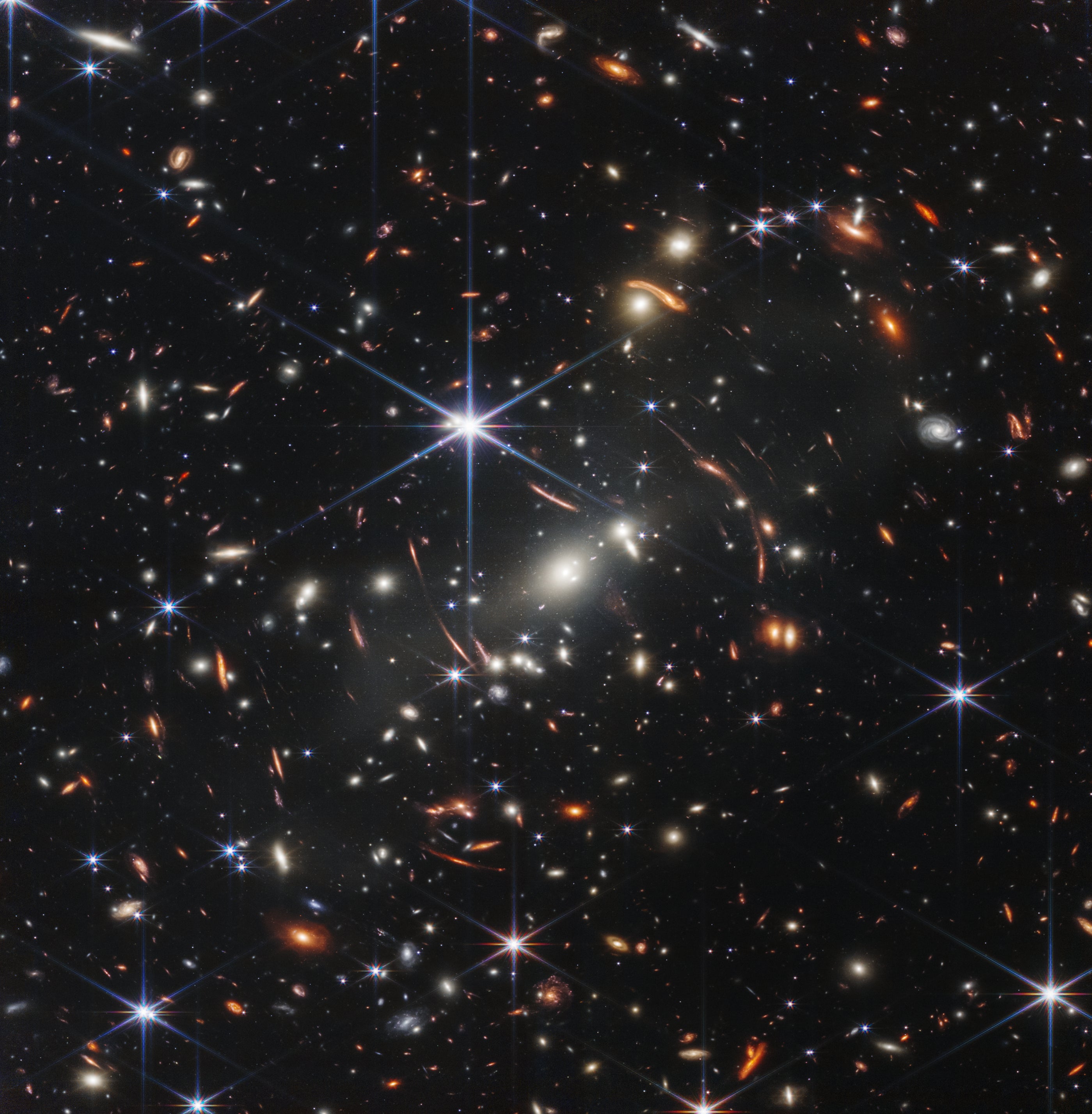
“The very red objects are telling you these are very distant galaxies,” Dr Bean said. “Anything red in that kind of image tells you it’s quite old, it’s very distant.”
That’s because the light from the most distant objects in the universe has been stretched over time, those light waves being stretched out by the expansion of the universe itself over billions of years. As the light’s wavelength became longer, it shifted out of the range of visible light and into the infrared end of the spectrum — Webb is a purely infrared telescope, and an exquisitely sensitive one, for just this reason.
However, even Webb’s finely tuned instruments and huge mirror couldn’t resolve the most distant galaxies seen in the deep field image without assistance.
Looking closely at the image, you can see some distortion in the shapes of galaxies around the center. This is because Webb focused on SMACS 0723, a cluster of galaxies closer to Earth at just more than 4 billion light years away.
The gravity of the massive galaxy cluster acts like a lens, bending and magnifying the light of the vastly more distant galaxies behind the cluster. Using this technique, known as gravitational lensing, scientists will soon use Webb to peer much further back in time. Ideally, to look back as early as 200 million years after the Big Bang to capture the formation of the very first galaxies in the Cosmos.
The Carina Nebula is a vast cloud of gas, dust, and a nursery for newborn stars located about 7,600 light years from Earth in the Southern constellation of Carina. Webb’s image of the Carina Nebula focuses on one portion of the larger nebular known as NGC 3324, or the “cosmic cliffs” due to its similarity to a mountainous skyline. The tallest of the peaks in the image, however, are seven light years long. That’s longer than the distance between Earth and the nearest star, Proxima Centauri.
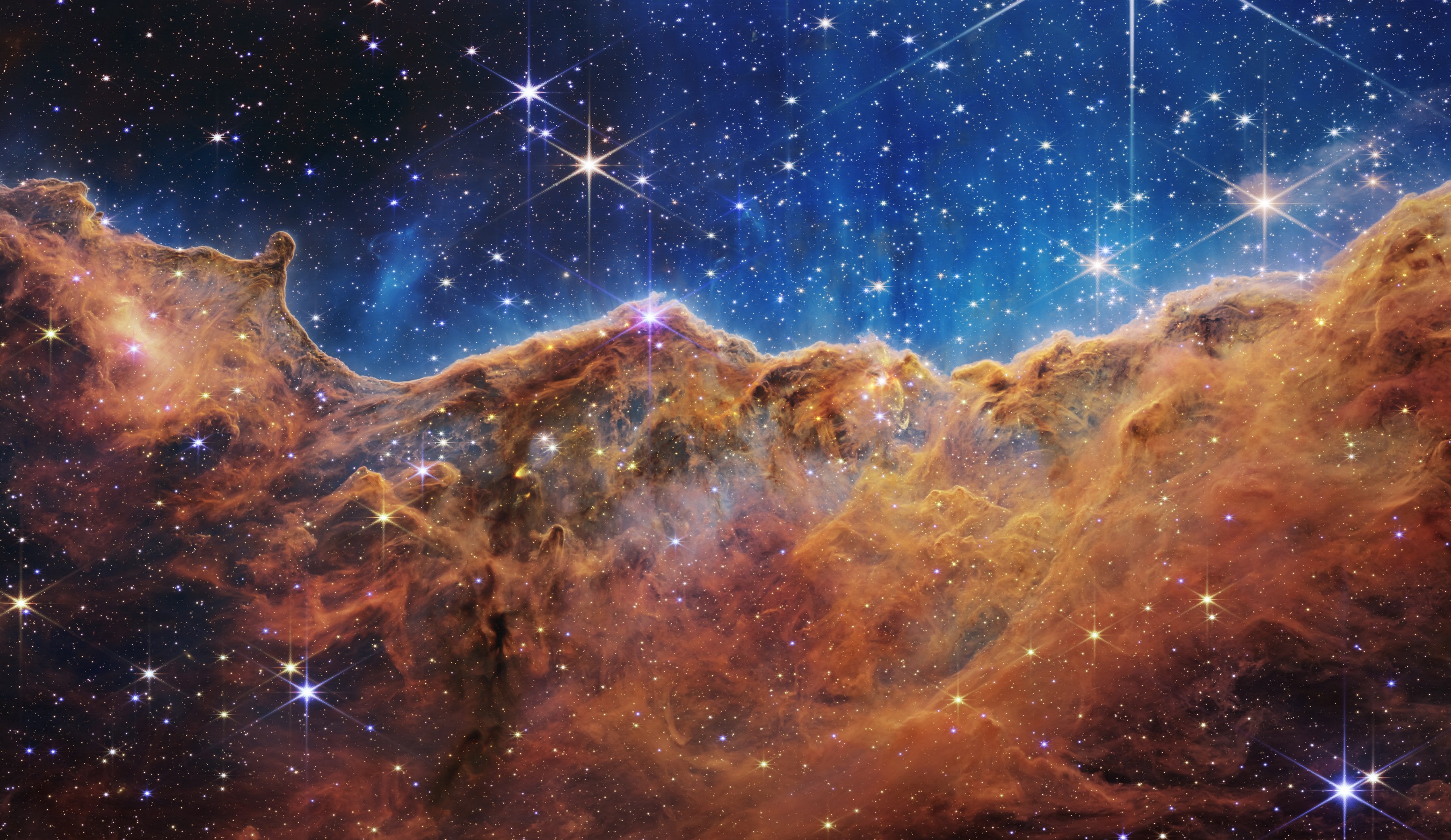
Webb’s Carina image was created by merging data taken with both the telescope’s near-infrared camera (NIRCam) and mid-infrared instrument (Miri), which revealed aspects of the nebula hidden in earlier observations by Hubble. The addition of the Miri reveals young stars with planet-forming disks that appear pink or reddish, along with outflowing jets of gas.
Unlike Carina, the Southern Ring Nebula is not a stellar nursery, but a stellar nursing home, the glowing layers of gas and dust expelled by a dying star at the planetary nebula’s center. Located around 2,500 light years from Earth, Webb viewed the nebula with both its NIRCam Miri instruments, each of which revealed different details.
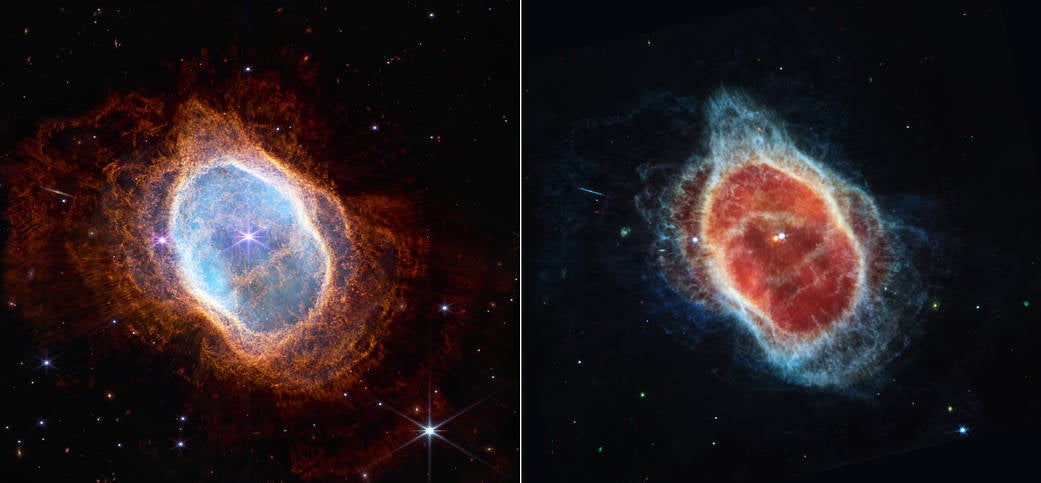
NIRCam imaging highlights the bright stars and complex layering of the nebula’s gas, while the Miri image makes it clear there are two stars orbiting each other at the nebula’s center. The fainter star is on its deathbed, and the source of the nebula’s gas, while the brighter star is younger, though it will eventually share the older star’s fate and contribute its own gas to the Nebula.
The gas and dust released by planetary nebulae may ultimately become part of other stars or their planets.
Stephan’s Quintet is a grouping of five galaxies as seen from Earth. Only four of the galaxies are relatively close to each other, about 290 million light years from Earth, with the fifth foreground galaxy located only 40 million light years away. A far less detailed image of the quintet of galaxies appeared in the American holiday film starring Jimmy Stewart, “It’s a Wonderful Life.”
Webb’s image — the telescope’s largest so far and composed of 1,000 separate image files — documents how the gravity of the four close, interacting galaxies generates shock waves, and pulls stars and gas out from each other. Webb’s instruments also revealed material ejected the supermassive black hole in one galaxy’s center, an actively feeding black hole putting out energy equivalent to 40 billion Suns.
“These large mosaics of images of galaxies and nebulae just reveal so much fine detail that I think it’s going to really tell us about the physics of these objects,” Dr Bean told The Independent, “to understand what’s driving what we’re seeing there.”
Yet the Webb image that most excited Dr Bean wasn’t a vast nebula or distant galaxy, but the spectrum of exoplanet Wasp-96b, the pattern generated by observing starlight filtering through the planet’s atmosphere. Because different molecules absorb different wavelengths of light, a spectrum can tell scientists about the chemical makeup of distant objects.
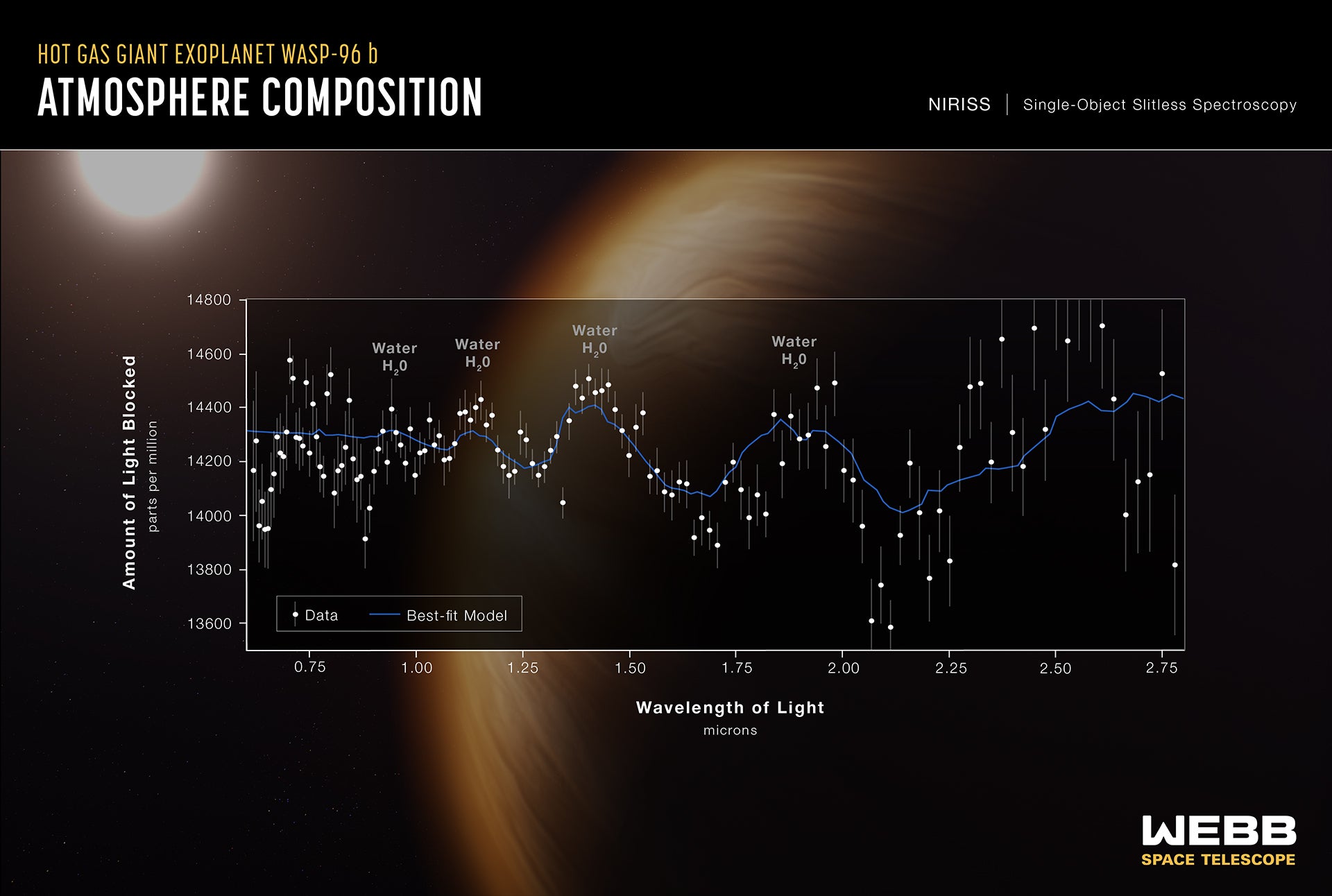
“What’s special about that spectrum is that you see, very clearly just by eye, the bumps and wiggles in the spectrum that are due to water vapor,” Dr Bean said. Hubble and other instruments have detected water vapor in exoplanet spectra before, but “there’s just so much more information there, there’s more subtle bumps and wiggles that could be due to other chemical species.”
It’s the most detailed spectrum of an exoplanet ever collected, Dr Bean added, and it was collected much more casually than forthcoming exoplanet spectra taken as part of scientific investigations.
“We’ll refine those spectra. We’re going to do this for lots of other planets. We’re going to expand the wavelength range, so we can see many more chemical species beyond water,” he said. “In the long run, maybe we can search for signs of life in exoplanet atmospheres, all using this kind of technique that was used to produce a spectrum from Wasp-96b.”
Dr Bean has studied exoplanets for more than a decade in anticipation of the day Webb would finally begin to peer out into space. He’s excited to be a part of a large group already studying the spectrum of Wasp-96b. But as exciting as the technical achievements that led to this moment, and the moments of scientific discovery yet to come may be, he believes Webb can inspire in people something more universal.
“I think it means something quite important beyond science, which is what we can achieve when people find common ground and work together,” Dr Bean said, noting Webb is a collaboration between thousands of people, scientists, engineers, and program managers, across the US, Canada, and the European Space Agency.
“Look what we can achieve when we find that common ground and work together, these beautiful images of outer space, a deeper understanding of our universe that we live in.”
Join our commenting forum
Join thought-provoking conversations, follow other Independent readers and see their replies
Comments